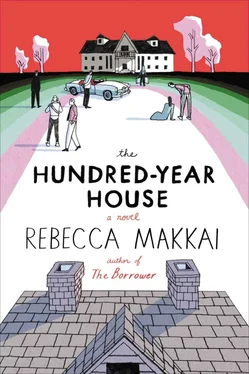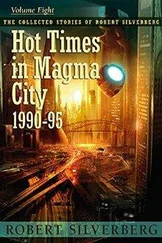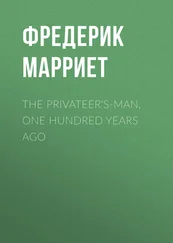Past the library, past the co-op.
All the way to her car. She couldn’t feel her feet.
She drove off campus with the conviction, the finality, of someone driving off the entire planet.
Doug had started to see the world as reticulated. The way the colored pieces of any view fit together: windowsill, wall, sky, driveway, tree, roof. Shoe, carpet, book. If you looked long enough, the three-dimensional world flattened to a plane where every block of color was a tile, so tightly clicked together that no mortar showed at the cracks.
He stared at the Happensack for hours a day, whether Miriam was in front of it smoothing mortar over the top and scrubbing it off with a hard sponge, or whether he was alone at two a.m. as Miriam, similarly insomniac, worked downstairs on other things. They continued to sleep in the kitchen. The first night, he hadn’t gone to bed at all. He’d been at the police station, and then slumped at Gracie’s table. (“What did you do ?” Gracie kept saying, until Doug worried the officers would think he’d strangled his wife.) The police traipsed through the coach house. “Talk about the writing on the wall,” one said, unhelpfully, and even his partner didn’t laugh. The second night, he’d been downtown meeting a private detective, and afterward he made it only back up to Leland’s place, where he lay on the couch for five hours but didn’t sleep. The third night, Miriam told him he needed to lie down. She zipped him in and brought him a pill and put a washcloth on his forehead, and then it was morning. And for fifty nights since then, he’d crawled in four feet away from her.
He worried the hard kitchen floor would ruin his back, but it didn’t. Dr. Morsi agreed: Regardless of the disintegration of his heart and brain, his back had never been better.
—
Gracie had accused him, in those first weeks, of telling Zee what he knew. She said, “It would have pushed her over the edge. She worshipped her father.” Doug might have asked which father, and who Zee’s father even was, if her father was a chauffeur named Max, if her father had perhaps posed nude by the koi ponds. But his jaw was full of lead, and Gracie was in a dull and constant rage. He only encountered her now on the driveway, roaring past in the Mercedes. It was a miracle of good timing that Doug had gotten the files out of the attic the day before Zee left, or Gracie might never have handed over the key at all.
Although the Parfitt file was still conspicuously missing — he and Miriam wondered if it was actually Zee who’d replaced it with the photo, falling apart long before he knew it but one step ahead as always — the rest was a treasure trove. If he could have crawled into the files to live, and never had to worry about food or detectives or showering, he’d have done it. There were sheaths of correspondence between the longtime director, Samantha Mays, and the artists and writers and composers who saw her as their guardian angel. There were slides of paintings. Miriam pored over the Demuth ones, comparing them to prints in library books and calling a friend at the School of the Art Institute who drove up to borrow them, along with the Grant Wood slides and the files of artists Doug hadn’t heard of. There were project proposals and sample work. There were letters of recommendation.
Miriam was most excited about the files of two female sculptors, Fannie Cadfael and Josephine Lizer. “I knew it,” she said. “I knew it, I knew it, I knew it! The bear statue, in the woods! I knew that was a Lizer. I should’ve said so! White rabbits!” Even Doug registered, through his haze, that this made no sense. Miriam explained, her hands flying, that the White Rabbits were the women who had assisted the sculptor Lorado Taft before the Columbian Exposition in 1893. Taft begged special permission to use women, until the man in charge snapped that he could use white rabbits if they’d get the job done. Those women proudly clung to the name as they launched their own careers as some of the first successful female sculptors. A Josephine Lizer piece, even one covered with moss, was a big enough deal that it sent Miriam running for the phone.
Less valuable but more personally intriguing were the references, in the forties and fifties, to a colony caretaker named Maxwell Perry. “That has to be Max!” Doug said. “And he stayed after they kicked the artists out.”
Miriam said, “Well, sure, that was probably really the driver’s name, and he’d probably really been the caretaker. When people lie, they don’t make up all the details.”
Leland just said, “Any caretakers named Marianne Moore?”
Parfitt, it seemed, had stayed at least six times, and as late as 1941, just four years before his suicide. Some rosters listed his apartment on Rush Street in Chicago, and the earliest — in 1929—had a Philadelphia address that was news to Doug. The most useful detail was the fact that for every stay but the last, his lover, the artist Armand Cox, had been there at the same time. (“ Armand Cox ?” Miriam said. “That’s his real name?”) It meant their relationship started earlier than was thought. Doug imagined Parfitt writing at a Laurelfield desk, his partner down in a studio designing stage sets and drawing his magazine covers, his fadeaway girls. The two reuniting at the dinner table, discussing the day’s work.
Even so, it wasn’t enough. Doug tried his best, in the blur of weeks after Zee left, to imagine what a project centered around these scraps of information might look like. And then, the punch in the gut: In late March, a professor from Yale published a long article on Parfitt in The New Yorker , a rediscovery piece. The professor, said his bio, was about to publish a book on the lost modernists. It wasn’t that his work entirely supplanted Doug’s. It was that ten other people were now going to get the same idea, and do it better, and do it faster, and be more qualified to tell the story.
But Doug imagined he might write a nonacademic article about Laurelfield itself, or about artists’ residencies in the 1920s. He could drive to other colonies, the places that still kept their records in dusty attics. He had a hell of a story for the introduction, at least: the first-person narrative of recovering the lost Laurelfield archive.
He spoke to the historical society about taking the files off his hands once he’d copied the parts he wanted.
These papers were the trails of the artists — and, in the cases of the most obscure visitors, these might have been the only remnants of their art. But what trail he himself had left, what had prompted Zee to choose that word, trail , for the wall, he still wasn’t sure. Something told him it wasn’t a trail up the attic stairs, but something that had led her to Melissa Hopper and her soccer tryouts, her babysitting gigs, her crushes — yet the trailhead was missing. He’d hidden every scrap of paper, scoured his desk every day before Zee came home. He felt stupid, or at least outsmarted. He had a thousand imaginary conversations with her. The speech evolved and mutated. It went through angry cycles, conciliatory ones, and there was a pleading phase. It grew shorter and more concise. Eventually it became a single and blanketing word, a one-breath mantra: “ No .” With every step around the fish ponds, every thrash in his sleep. No to it all. No, this didn’t happen. No, you couldn’t have been in your right mind. No, I’m not the pathetic slug you think I am. No, I didn’t want this. No, I don’t take it back. No. No. No. No. No.
A package arrived in the mail: Melissa Calls the Shots, Melissa Takes a Bow, Cece Makes the Grade . He dumped them in a desk drawer. He spent the day wishing he could call Zee and tell her that the changes she’d made just weren’t working for him. “You altered the universe,” he’d say. “We’re going to ask you to start over.”
Читать дальше












